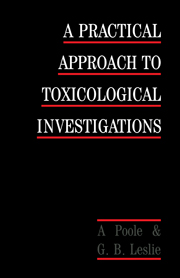Book contents
- Frontmatter
- Contents
- Foreword
- Preface
- List of abbreviations
- 1 Introduction
- 2 Regulatory requirements
- 3 Animals: sources, selection, husbandry
- 4 Standard studies in animals
- 5 Measurements and observations made in living animals
- 6 Terminal studies
- 7 Specialised routes of exposure
- 8 Reproductive toxicology
- 9 Genotoxicity
- Appendix 1 Toxicology data requirements for clinical trial approval and registration of new drugs
- Appendix 2 Countries and addresses of regulatory agencies
- Index
2 - Regulatory requirements
Published online by Cambridge University Press: 04 August 2010
- Frontmatter
- Contents
- Foreword
- Preface
- List of abbreviations
- 1 Introduction
- 2 Regulatory requirements
- 3 Animals: sources, selection, husbandry
- 4 Standard studies in animals
- 5 Measurements and observations made in living animals
- 6 Terminal studies
- 7 Specialised routes of exposure
- 8 Reproductive toxicology
- 9 Genotoxicity
- Appendix 1 Toxicology data requirements for clinical trial approval and registration of new drugs
- Appendix 2 Countries and addresses of regulatory agencies
- Index
Summary
The self-evident goal of pharmaceutical companies is to develop and market high quality, efficacious and safe drugs. The consequences of marketing drugs which have been inadequately evaluated for safety could be so damaging to a company that self regulation should be adequate to ensure that the highest standards of testing are achieved. However, while most companies have worked to very high standards (both scientifically and ethically) there have been, unfortunately, occasions when such ideals have not been achieved. As a result of such lapses legislation has been introduced in an endeavour to ensure that safety testing should reach acceptable minimum standards.
PRECLINICAL SAFETY TESTING LEGISLATION
The Federal Food, Drug and Cosmetic Act introduced in the USA in 1938 is the oldest law introduced to regulate the exposure of humans and animals to drugs, medical devices and cosmetics. The original act has been amended several times and now requires that drugs must be both effective for the labelled indication and safe. In the USA, the Food and Drug Administration (FDA) is responsible for the safety testing of therapeutic agents and, in common with other regulatory authorities, has specified programmes for preclinical toxicity testing.
In the UK the first regulatory agency, established in response to the thalidomide tragedy, was a voluntary committee (Committee on the Safety of Drugs) set up by the pharmaceutical industry and chaired by Sir Derrick Dunlop. However, the Medicines Act of 1968 gave statutory powers to a Committee on the Safety of Medicines.
- Type
- Chapter
- Information
- A Practical Approach to Toxicological Investigations , pp. 10 - 29Publisher: Cambridge University PressPrint publication year: 1989



